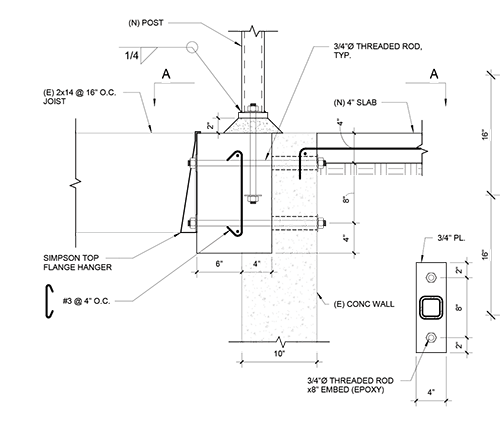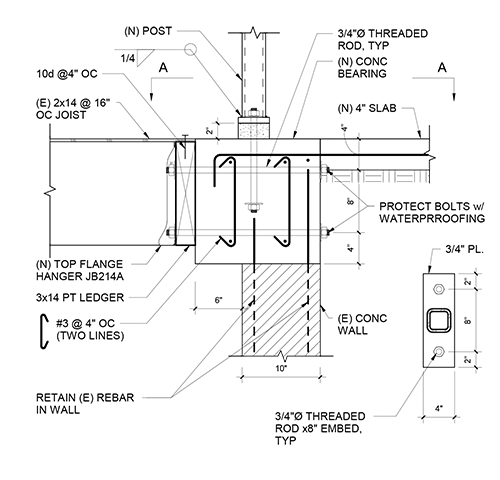By John A. Dal Pino
I was drawing up details for a current project the other day when I realized just how much fun I was having. Yes, fun! I had been at it for several hours and never once thought about getting up from my seat or checking my phone to see the odds on upcoming NFL games.
I suppose that is the definition of fun: Doing something that gives you joy and fulfillment. And I would add: Continuing with the activity with no thought about doing something else. That may be overstating the “fun” I was having, but you get the idea.
STRUCTURE’s Editorial Board has long had an internal article category called Engineer’s Notebook. We hoped that structural engineers at all levels would be willing to share tools that they had picked up that helped them in their work, such as a handy spreadsheet that solved repetitive calculations, a trick for estimating the solution, a better way to file documents, etc. We get an article from time to time that fits the bill, but not as many as we hoped for. Maybe we haven’t advertised our desire enough? I figured that engineers just don’t want to share their time and money-saving ideas with their competitors broadly.
So, I got the idea the other day, after finishing having fun, to start the development of a series in STRUCTURE where we can share those aspects of structural engineering that you consider “fun.” Sharing what we really like to do seemed like a way to get the same result but with a less threatening angle of attack. Your marketing staff will be thrilled to post your “WHAT I LOVE ABOUT STRUCTURAL ENGINEERING” story on your company website.
I suppose that my love of detailing started in junior high school. Back then, Centerville Junior High School in Fremont, California, offered mechanical drawing (drafting), wood shop, and metal shop as electives. The classes were related in that to build something, you first drew up a rough plan (a schematic sketch) and then determined how much material was needed (in wood shop, we learned how to calculate quantities in board feet, which determined the material cost), what the shapes were going to look like and how it was all supposed to fit together (design development), and if the order of assembly was critical, what went first and what went last.
I remember making sheet metal boxes by first drawing up what the piece needed to look like when folded flat (sheet metal drawing), where the fold lines would be, and how the corners would eventually be joined. After designing and getting the okay from the teacher, I then inserted a metal sheet into a large, menacing-looking metal bending and cutting machine, final trimming of the sheet with hand shears and then folding the sheet with a metal press into a box and joining the corners, some with rivets and some with solder, so I learned how to do both. Students did similar things in the wood shop. Looking back, I am happy that I didn’t cut off any fingers or lose an eye when using the table saw, the band saw, or the wood lathe, although those possibilities certainly crossed my mind. My mother still has a wood lamp and some glue-laminated candleholders I made.
At Washington Township High School, also in Fremont, I continued with four years of mechanical drawing and also took auto shop. Auto shop was a less serious affair, but I still remember learning that a car needs fuel, spark, and air to run (and today advanced computers), to always connect the red, positive lead to a battery before the black, negative one and that fixing a dented fender is a lot harder than it looks.
This brings me back to the structural detailing. I first envision all of the constraints, then determine all of the pieces and parts that I will need, and consider the sizes of the pieces and parts (actual sizes, not the single lines we draw). I consider that if I was to build the thing, how would I do it, i.e., where would I stand, where would my hands go, if welding is needed, can the welder’s rod touch the joint at something close to a 45-degree angle, and if it needs drilling, how much space is needed to allow for the drill motor with the drill bit inserted? In addition to these physical aspects, I also have to develop the loads and reactions and provide enough material strength for the detail to work. I rarely find that having enough material strength is the issue unless, of course, I am detailing a complicated wood connection where the bolt spacing and edge distance requirements are usually the key factor. If your planning allows for it to all come together, and it works, you experience joy and fulfillment, or in other words, fun. That is the best part of structural engineering to me, plus going to the site to watch craftsmen build what I dreamt up. The last thing I built by hand was a chicken coop for Thelma and Louise with material from a discarded wood pallet I found at the bottom of a freeway off-ramp.
My favorite detailing challenges involve reinforced concrete. Besides the aforementioned wood detailing (if you are good at detailing heavy timber trusses for snow country, I tip my hat to you), I think concrete connections require the most artistic skill and conception since reinforced concrete components can be designed in almost any size and shape. With the required bending, shear, and axial forces in mind, key considerations are bar sizes (consider development length), bar spacing within and between layers (need to avoid rock pockets and voids), actual sizes of bends and hooks, bar layers crossing in joints, bar lengths required within the joint and the ever-important assembly sequence. It takes a while to learn that small joints/members need small bars and that as the concrete element grows, larger bars can be used, but all of the considerations still exist.


I will never forget developing details for a major airport project when my team and I received a call requesting our immediate attendance at the construction trailer so we could show everyone how the bars in the joint were to be assembled. The detailer who developed the shop drawings didn’t anticipate an issue, nor did we. After we went out to have a look and got lectured by some very angry, frustrated, and rough-looking iron workers, we went back to the construction trailer with our tails between our legs and developed a sequence that they could follow. We found that the last steps of the assembly sequence were, in fact, impossible to build with the rebar prepared per the shop drawings, and as a result, we changed some of the bar shapes by breaking them into multiple parts with lap splices. We apologized to the iron workers, and everyone was happy afterward since ironworkers have fun assembling rebar without having to fight it.
Besides reinforced concrete, I find joy in bringing together different types of materials in a single detail. One of the details I worked on recently involved landing a new, lightly loaded steel post on the top of an existing concrete retaining wall. It seemed straightforward enough until I realized that the steel post would land partly on the existing wood floor joists and partly on the concrete and eccentrically to the concrete wall, which was to support the gravity load. I decided to trim back the wood, cast concrete in the wall shelf where the wood joists originally landed, re-support the joists on the concrete, and finally install the steel post. I would join the new concrete to the old with external bolts rather than rebar due to the lack of development length across the width of the concrete. Another alternative I considered was to trim back both the joists and remove the top of the existing wall entirely, save the existing reinforcement, and cast back a larger concrete block to support the post. The second option is clearly better but more expensive. What should I do? What would you do? See Figure 1 for the original details and the two alternatives.
Please think about the aspects of structural engineering you like the best, the fun parts, and write an article for STRUCTURE. ■
John A. Dal Pino is a Principal with Claremont Engineers, Inc. in Oakland, California. He serves as the Chair of the STRUCTURE Editorial Board (jdalpino@claremontengineers.com).
